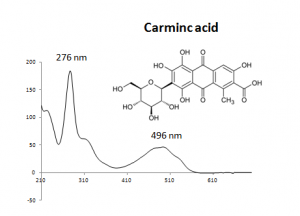Difference between revisions of "Cochineal (Dactylopius coccus) LC"
| (3 intermediate revisions by the same user not shown) | |||
| Line 1: | Line 1: | ||
| − | [[File:|thumb|''' | + | [[File:Cochinealdry.jpg|thumb|'''dried cochineal insects photo by X. Zhang]] |
== Description == | == Description == | ||
| + | The cochineal is a scale insect in the suborder Sternorrhyncha, from which the natural dye carmine is derived. Cochineal lives on catcti in the genus Opuntia. Cochineal is native to tropical and subtropical South America as well as Mexico and Arizona. These insects are brushed off and dried for storage. | ||
| + | |||
| + | The insect produces carminic acid that deters predation by other insects. Carminic acid, typically 17-24% of dried insects' weight, can be extracted, then mixed with aluminium or calcium salts to make carmine dye. | ||
== Historical importance == | == Historical importance == | ||
| Line 13: | Line 16: | ||
== Analytical instrumentation and procedures == | == Analytical instrumentation and procedures == | ||
| + | HPLC-DAD-MS analysis was performed with an Agilent 1100 liquid chromatography system consisting of an automatic injector, a gradient pump, a HP series 1100 DAD, and an Agilent series 1100 VL on-line atmospheric pressure ionization electrospray ionization mass spectrometer. Separations were done on a Vydac 214TP52 analytical column (2.1 mm diameterX250 mm; 5-ím particle size). The column was eluted at a flow rate of 0.2 mL/min with a tertiary gradient of water (A),acetonitrile (B), and 1% (v/v) aqueous formic acid (C) with the following elution program: 0 min, 90% A, 5% B, 5% C; 0-55 min, a linear gradient to 35% A, 60% B, 5% C; 55-60 min, a linear gradient elution to 15% A, 80% B, 5% C; 60-62 min, isocratic elution at 15% A, 80% B, 5% C; 62-70 min gradient elution to 90% A, 5% B, 5% C; and reequilibration with the latter solvent for 15 min. The mass spectrometer was run both in the negative and positive ion mode. | ||
== Chromatograms == | == Chromatograms == | ||
Latest revision as of 09:22, 29 September 2017
Description
The cochineal is a scale insect in the suborder Sternorrhyncha, from which the natural dye carmine is derived. Cochineal lives on catcti in the genus Opuntia. Cochineal is native to tropical and subtropical South America as well as Mexico and Arizona. These insects are brushed off and dried for storage.
The insect produces carminic acid that deters predation by other insects. Carminic acid, typically 17-24% of dried insects' weight, can be extracted, then mixed with aluminium or calcium salts to make carmine dye.
Historical importance
Summary of results
Analytical instrumentation and procedures
HPLC-DAD-MS analysis was performed with an Agilent 1100 liquid chromatography system consisting of an automatic injector, a gradient pump, a HP series 1100 DAD, and an Agilent series 1100 VL on-line atmospheric pressure ionization electrospray ionization mass spectrometer. Separations were done on a Vydac 214TP52 analytical column (2.1 mm diameterX250 mm; 5-ím particle size). The column was eluted at a flow rate of 0.2 mL/min with a tertiary gradient of water (A),acetonitrile (B), and 1% (v/v) aqueous formic acid (C) with the following elution program: 0 min, 90% A, 5% B, 5% C; 0-55 min, a linear gradient to 35% A, 60% B, 5% C; 55-60 min, a linear gradient elution to 15% A, 80% B, 5% C; 60-62 min, isocratic elution at 15% A, 80% B, 5% C; 62-70 min gradient elution to 90% A, 5% B, 5% C; and reequilibration with the latter solvent for 15 min. The mass spectrometer was run both in the negative and positive ion mode.
Chromatograms
Sample information
Identified compounds
| Compound | RT (min.) | MW | UV/vis | Other |
|---|---|---|---|---|
| carminic acid | xx0 | xx | xx | Comments here |
| x | x | x | x | |
| x | x | x | x | |
| x | x | x | x |
References
[1] [2] [3]


